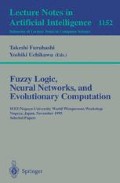Abstract
The advantages of fuzzy sets and neural networks in emulating the human brain capabilities motivated the development of fuzzy neural networks. Various models of fuzzy neurons have been proposed as the basic element of fuzzy neural networks. In this paper, we introduce a generic fuzzy neuron as an extension of existing fuzzy neuron models. In our model, all the states of activity are given in terms of fuzzy sets with relative grades of membership distributed over the interval [0, 1]. The inputs and outputs are fuzzy sets over different universes of discourse. The connection, aggregation, and activation functions, which determine the operation of the neuron, are fuzzy relations. When the inputs to a function are fuzzy sets over the same universe of discourse, the function can be any fuzzy operation in class of triangular norms or triangular conorms. To evaluate the operation of the fuzzy neuron, a fuzzy neural network architecture based on the generic fuzzy neuron has been developed for motion estimation. The five-layer feedforward fuzzy neural network emulates a fuzzy motion estimation algorithm. Seven simplified versions of fuzzy neurons are defined and utilized in the fuzzy neural network. The results of simulations on thousands of 64×64, 6-bit synthetic image frames containing moving objects under different conditions are reported.
Preview
Unable to display preview. Download preview PDF.
References
M.M. Gupta, G.K. Knopf, “Fuzzy Neural Network Approach to Control Systems,” B.M. Ayyub, M.M. Gupta, L.N. Kanal, Analysis and Management of Uncertainty: Theory and Applications. Elsevier Science Publishers B.V., 1992.
K. Hirota, W. Pedrycz, “OR/AND Neuron in Modeling Fuzzy Set Connectives,” IEEE Trans. on Fuzzy Systems, vol. 2, no. 2, pp. 151–161, 1994.
B. Jahne, Spatio-temporal Image Processing: Theory and Scientific Applications. Springer Verlag, Berlin New York, 1993.
J.S.R. Jang, “ANFIS:Adaptive-Network-Based Fuzzy Inference Systems,” IEEE Trans. on Systems, Man, and Cybernetics, vol. SMC-3, pp. 28–44, 1992.
J.M. Keller, H. Tahani, “Implementation of Conjuctive and Disjunctive Fuzzy Logic Rules With Neural Networks,” Int'l J. Approximate Reasoning, vol. 6, pp. 221–240, 1992.
B. Kosko, Neural Networks and Fuzzy Systems: A Dynamical Systems Approach to Machine Intelligence. Prentice Hall, Inc., Englewood Cliffs, NJ, 1992.
A.Z. Kouzani, A Fuzzy Neural Network and its Application to Motion Detection and Velocity Estimation. M.Eng.Sc. Thesis, University of Adelaide, Adelaide, Australia, January, 1995.
H. K. Kwan, Y. Cai, “A Fuzzy Neural Network and its Application to Pattern Recognition,” IEEE Trans. on Fuzzy Systems, vol. 2, no. 3, pp. 185–193, 1994.
S.C. Lee, E. T. Lee, “Fuzzy Neural Networks,” Mathematical Biosciences, vol. 23, pp. 151–177, 1975.
H. Li, H.S. Yang, “Fast and Reliable Image Enhancement Using Fuzzy Relaxation Technique,” IEEE Trans. on Systems, Man, and Cybernetics, vol. SMC-19, no. 5, pp. 1276–1281, 1989.
J.N. Lin, S.M. Song, “A Novel Neural Network for the Control of Complex Systems,” 1994.
W.S. McCulloch, W.H. Pitts, “A Logical Calculus of Ideas Immanent In Nervous Activity,” Bull. Math. Biophys., vol. 5, pp. 115–133, 1943.
A. Mitiche, Computational Analysis of Visual Motion. Plenum Press, New York, 1994.
S.K. Pal, R.A. King, “Image Enhancement Using Smoothing with Fuzzy Sets,” IEEE Trans. Syst., Man, Cybern., vol. SMC-11, no. 7, pp. 494–501, 1981.
S.K. Pal, A. Rosenfeld, “Image Enhancement and Thresholding by Optimization of Fuzzy Compactness,” Pattern Recognition Letters, vol. 7, pp. 77–86, 1988.
W. Pedrycz, “Neurocomputing in Relational Systems,” IEEE Trans. on Pattern Analysis and Machine Intelligence, vol. 13, no. 3, pp. 289–296, 1991.
W. Pedrycz, A.F. Rocha, “Fuzzy-Set Based Modeles of Neurons and Knowledge-Based Networks,” IEEE Trans. on Fuzzy Systems, vol. 1, no. 4, pp. 254–266, 1993.
H. Takagi, I. Hayashi, “NN-Driven Fuzzy Reasoning.” Int'l J. Approximate Reasoning, vol. 5, no. 3, pp. 191–212, 1991.
W.B. Thompson, S.T. Barnard, “Lower-Level Estimation and Interpretation of Visual Motion,” Computer, 14, no. 8, pp. 20–28, 1981.
T. Yamakawa, S. Tomoda, “A Fuzzy Neuron and Its Application to Pattern Recognition,” Proc. Third IFSA Congress, Washington, pp. 943–948, August 6–11, 1989.
T. Yamakawa, M. Furukawa, “A Design Algorithm of Membership Functions for A Fuzzy Neuron using Example-Based Learning.” IEEE International Conference on Fuzzy Systems, March 8–12,1992, San Diego, California. IEEE Press, 1992.
L.A. Zadeh, “Fuzzy Sets,” Inform. Control, vol. 8, pp. 338–353, 1965.
Author information
Authors and Affiliations
Editor information
Rights and permissions
Copyright information
© 1996 Springer-Verlag Berlin Heidelberg
About this paper
Cite this paper
Kouzani, A.Z., Bouzerdoum, A. (1996). A generic fuzzy neuron and its application to motion estimation. In: Furuhashi, T., Uchikawa, Y. (eds) Fuzzy Logic, Neural Networks, and Evolutionary Computation. WWW 1995. Lecture Notes in Computer Science, vol 1152. Springer, Berlin, Heidelberg. https://doi.org/10.1007/3-540-61988-7_20
Download citation
DOI: https://doi.org/10.1007/3-540-61988-7_20
Published:
Publisher Name: Springer, Berlin, Heidelberg
Print ISBN: 978-3-540-61988-8
Online ISBN: 978-3-540-49581-9
eBook Packages: Springer Book Archive

